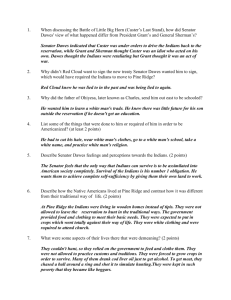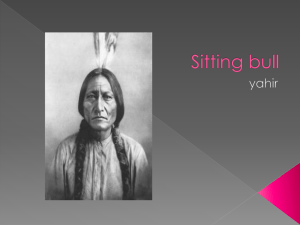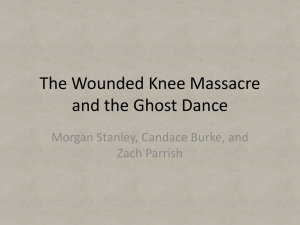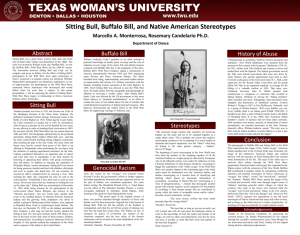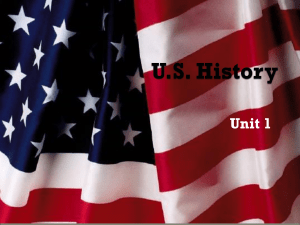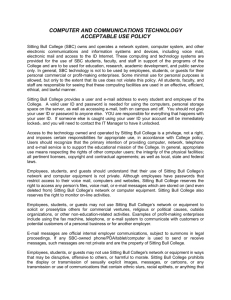Bury My Heart at Wounded Knee
advertisement
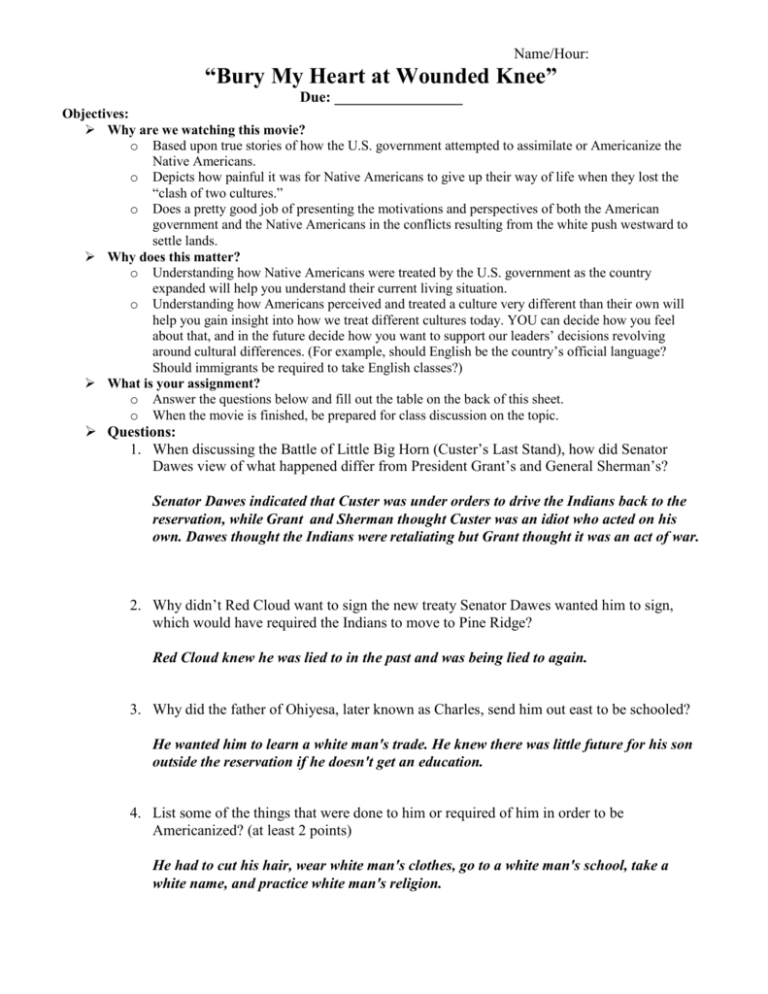
Name/Hour: “Bury My Heart at Wounded Knee” Due: _________________ Objectives: Why are we watching this movie? o Based upon true stories of how the U.S. government attempted to assimilate or Americanize the Native Americans. o Depicts how painful it was for Native Americans to give up their way of life when they lost the “clash of two cultures.” o Does a pretty good job of presenting the motivations and perspectives of both the American government and the Native Americans in the conflicts resulting from the white push westward to settle lands. Why does this matter? o Understanding how Native Americans were treated by the U.S. government as the country expanded will help you understand their current living situation. o Understanding how Americans perceived and treated a culture very different than their own will help you gain insight into how we treat different cultures today. YOU can decide how you feel about that, and in the future decide how you want to support our leaders’ decisions revolving around cultural differences. (For example, should English be the country’s official language? Should immigrants be required to take English classes?) What is your assignment? o Answer the questions below and fill out the table on the back of this sheet. o When the movie is finished, be prepared for class discussion on the topic. Questions: 1. When discussing the Battle of Little Big Horn (Custer’s Last Stand), how did Senator Dawes view of what happened differ from President Grant’s and General Sherman’s? Senator Dawes indicated that Custer was under orders to drive the Indians back to the reservation, while Grant and Sherman thought Custer was an idiot who acted on his own. Dawes thought the Indians were retaliating but Grant thought it was an act of war. 2. Why didn’t Red Cloud want to sign the new treaty Senator Dawes wanted him to sign, which would have required the Indians to move to Pine Ridge? Red Cloud knew he was lied to in the past and was being lied to again. 3. Why did the father of Ohiyesa, later known as Charles, send him out east to be schooled? He wanted him to learn a white man's trade. He knew there was little future for his son outside the reservation if he doesn't get an education. 4. List some of the things that were done to him or required of him in order to be Americanized? (at least 2 points) He had to cut his hair, wear white man's clothes, go to a white man's school, take a white name, and practice white man's religion. 5. Describe Senator Dawes feelings and perceptions towards the Indians. (2 points) The Senator feels that the only way that Indians can survive is to be assimilated into American society completely. Survival of the Indians is his number 1 obligation. He wants them to achieve complete self- sufficiency by giving them their own land to work. 6. Describe how the Native Americans lived at Pine Ridge and contrast how it was different from their traditional way of life. (2 points) At Pine Ridge the Indians were living in wooden homes instead of tipis. They were no allowed to leave the reservation to hunt in the traditional ways. The government provided food and clothing to meet their basic needs. They were expected to put in crops which went totally against their way of life. They wore white clothing and were required to attend church. 7. What were some aspects of their lives there that were demeaning? (2 points) They couldn't hunt, so they relied on the government to feed and clothe them. They were not allowed to practice customs and traditions. They were forced to grow crops in order to survive. Many of them drank cod liver oil just to get alcohol. To get meat, they chased a bull around a ring and shot it to simulate hunting. They were kept in such poverty that they became like beggars. 8. Were there aspects that were better than their traditional lives? In what way? They no longer lived in tipis which kept them out of the elements. They were educated to help them acquire skills necessary to survive off the reservation. 9. In what ways did Sitting Bull resist adopting the “white man’s” life? (2 points) Sitting Bull refused to live on reservations for a time. He left the Dakota's and took his people to Canada to live. He would not grow crops when he was living on the reservation. He did not want ration stamps, and he wanted to pass out supplies to his people himself. He allowed his people to dance the Ghost Dance. 10. Why do you think it mattered to the U.S. government whether or not Sitting Bull assimilated? Explain. (2 points) It probably mattered to the government because Sitting Bull was the respected leader of the Lakota Sioux people. If Sitting Bull were to embrace the idea of assimilation, he could persuade other members of the tribe to do so also. On the other hand, if Sitting Bull didn't assimilate, others would follow that example, too. 11. Describe some of the conflicts Charles felt about being Americanized and being a Native American. (2 points) One could see the torment he felt just in selecting his white name Charles. He held on to his past by keeping the feather from Little Big Horn. His ability to treat disease as a doctor and his native roots tormented him as the people were infected with white man's diseases and were dying. He was caught in a world between being a native person and a white person and didn't know where he really belonged. 12. How did the Canadians feel about the Indians? The Canadian government blamed the United States government for the troubles Indians had encountered and welcomed them into Canadian land as long as they didn’t steal other’s game or use Canada as a base to attack into the U.S. 13. Pay close attention to the conversation between Sitting Bull and the General while they’re on the blanket negotiating, and complete the following chart. Think about how they justify their position. Describe the General’s view of: Land He says the Indians came from other lands and took the land from them, which is no different than what is happening to them now. Describe Sitting Bull’s view of: He says they are the lands their people lived on before the white man came, given to them by Wankan Tanka. People cannot own land. Religion He says that Indians cannot use their Sitting Bull says that the Black Hills are religion to explain their desire for the their sacred hunting grounds, given to them Black Hills. by Wankan Tanka. Treaties Sitting Bull should honor the treaties like the rest of the tribes who have agreed to live on the reservations. Sitting Bull refused to recognize the other chiefs or the treaties they agreed to. Wars Miles tells Sitting Bull that his tribe had been fighting other Indians for hundreds of years before the white man came. Sitting Bull said that the whites gave the Sioux the guns and powder they needed to fight against their enemies and traded weapons with the Chippewa to drive them out of their homes. 14. There’s a saying that says, “To the victor goes the spoils.” Do you think that the Native people were treated fairly or unfairly by the United States government as a conquered nation? Or were the Indians getting what they had done to other tribes before and it’s just the way it goes when you lose a war? Would Native Americans no longer exist if they didn’t give in and do what was placed on them by the whites? Explain how you feel about the government trying to assimilate Native Americans rather than just accepting them and allowing them to keep their traditional way of life.
